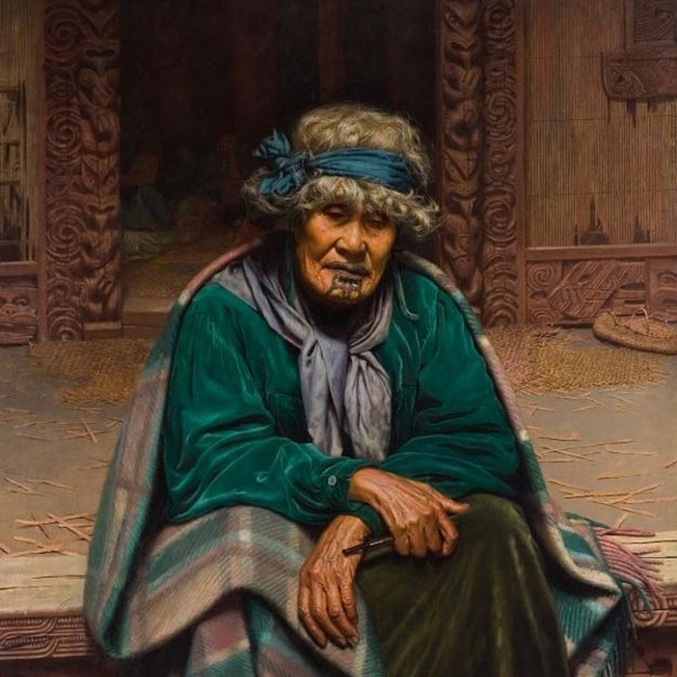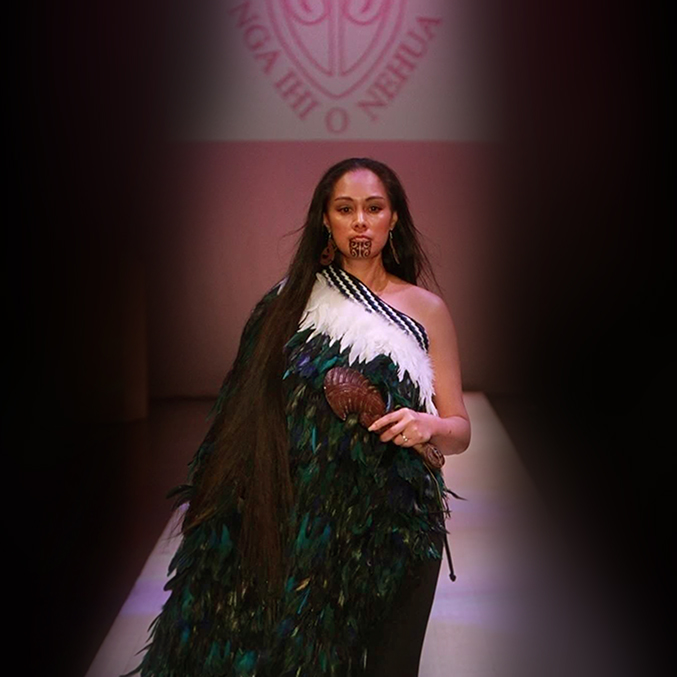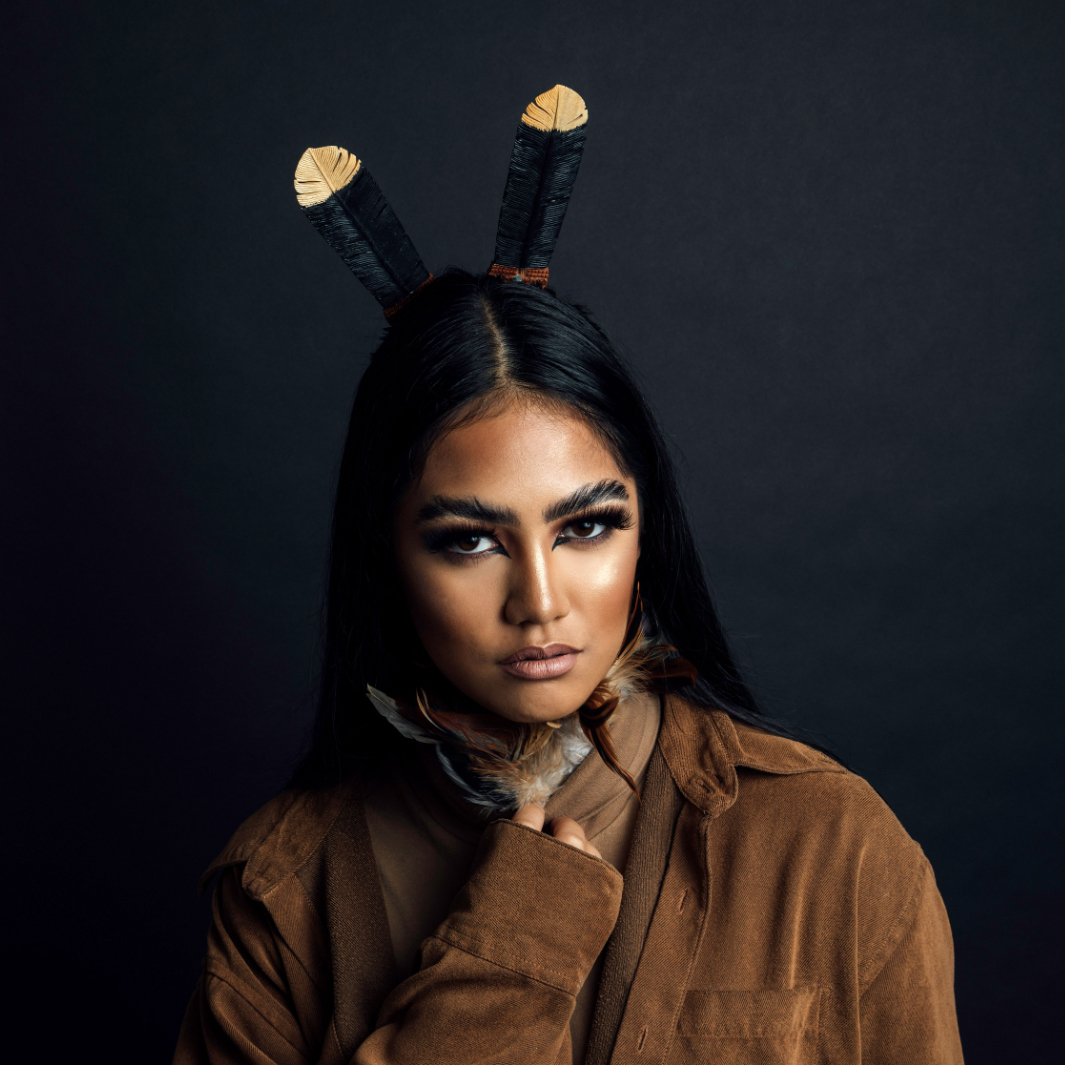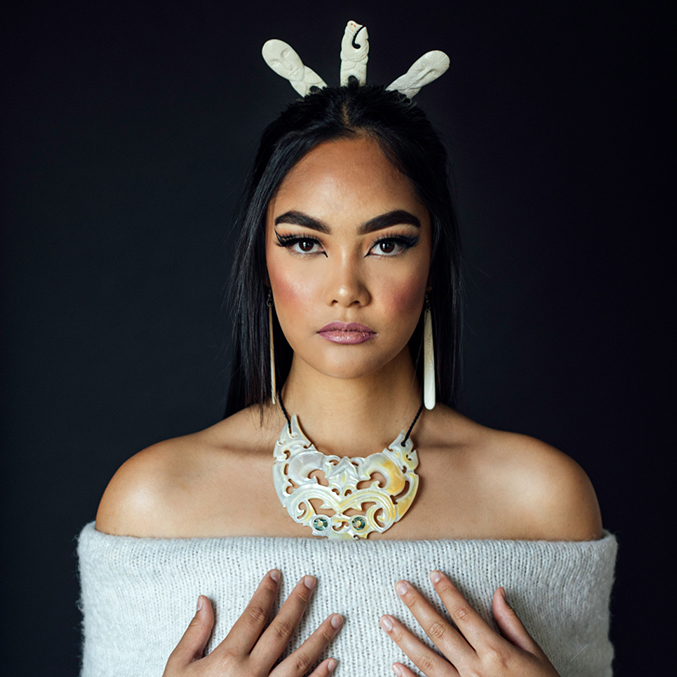
Hinauri and Sidney Nehua-Jackson. Photo by Noella Steinhauer. Makeup by Amanda Steinhauer
Sisters Hinauri Nehua-Jackson (19) and Sidney Nehua-Jackson (17), third-generation Māori model-activists from Aotearoa, New Zealand, will walk for First Nations designers Tishynah Buffalo and Doneese Bull-Buffalo at Rise New York Fashion Week (Rise NYFW) on Friday, September 9, 2022, at 256 W 37th St. This will be their first New York Fashion Week (NYFW) appearance and the first time Māori models will grace the Rise NYFW runway.
“The opportunities for a model in the BIWOC category are limitless,” Hinauri says. “This is our time.”
“We are truly grateful and honored to have these amazing women walk for our platform,” says Rise NYFW producer Lena T.
At Rise NYFW, independent fashion designers showcase their collections to a global audience of press, stylists, retailers, and industry influencers, championing diversity and giving emerging designers an opportunity to be seen and discovered.
Hinauri and Sidney have been invited to walk for designers Tishynah Buffalo and Doneese Bull-Buffalo. Tishynah Buffalo creates Indigenous fashion with a modern flare, pairing flowing fabrics with colorful native geometric patterns and detailed custom native beadwork, and has chosen models of all shapes, sizes, and skin tones to showcase her new Sâkihisowin Collection (Sâkihisowin translates to “self-love” in Nehiyawak, or Cree). Doneese Bull-Buffalo makes finely crafted ribbon skirts and matching side-bags decorated with colorful flowers and rainbows. Ribbon skirts are symbols of sacred, powerful resilience and survival, and they can be worn in support of social and environmental justice movements, such as Water is Life, Land Back, and Missing and Murdered Indigenous Women and Girls (MMIWG).
Hinauri and Sidney each received a Cosmic Sister Ancestor Medicine Award to help cover the expenses of traveling to New York for Rise NYFW and fund a professional studio photoshoot. The Cosmic Sister Medicine Award supports women who wish to explore and express cultural treasures (and traumas) from their genetic ancestral lines, with a focus on self-liberation and empowerment, and dis-covering and reclaiming herstory.
Hinauri and Sidney chose portrait artist Noella Steinhauer (@noellasteinhauer) and makeup artist Amanda Steinhauer (@forever_flawless_mu) for the photoshoot. Noella is Cree from Mikisew Cree First Nation and Fort McMurray 468 First Nation and focuses on photographing Indigenous women. “It’s just so important to me to show the beauty of our people,” she says. “We all come from a long line of beautiful, strong and resilient Indigenous families, and I hope it shows through my photography how proud, resilient, and gorgeous we all are.” She enjoyed working with the sisters. “They let me know that they have their own personalities and identities, which is something I truly admire and see in their images.” Amanda, who is Cree from Saddle Lake Cree Nation, helped Hinauri and Sidney shine. “The essence of truly modern makeup is the freedom to be yourself,” Amanda says, “to express who you are through makeup.”

Ena Te Papatahi, a tapairu (chieftainess) of the Ngapuhi tribe, painted by Charles F Goldie in 1906
Hinauri and Sidney were born and raised in Aotearoa, surrounded by and deeply connected to their Māoritanga (Māori culture). The sisters hail from a powerful matrilineal lineage of wāhine (female ancestors) and were raised to be “unapologetically Māori.” Their māmā (mother), Kateao Nehua-Jackson (41), is an Indigenous rights and reclamation activist-educator and the daughter of matriarch Deirdre Nehua (72), a Māori activist, matakite (“seer”), and poet. The line stretches back to Ena Te Papatahi, a tapairu (chieftainess) of the Ngapuhi tribe, Hinauri and Sidney’s tipuna (sixth great grandmother). Her portrait, painted by Charles F Goldie in 1906, is showcased in a position of honor at Auckland Museum.
In 2005, Kateao married a Nehiyawak (Cree) man, and the family moved to Amiskwaciy Waskahikan, the indigenous name for Edmonton, Alberta, Canada. “My sister and I are profoundly grateful for our mother’s efforts in keeping us rooted in Tikanga Māori while living in Canada,” says Sidney. The sisters have taught their language and culture in Alberta at festivals, special events, and educational institutes, and through modeling. They have been featured in Vogue, ELLE Canada, Complex, Windspeaker, Project Unity, and more. They have modeled for commercial and editorial photoshoots and on the runway, walking for Western Canada Fashion Week, Indigenous Fashion Week, Black History Month and Indigenous Empowerment Collective fashion shows, modeling modern Indigenous fashions by Helen Oro Designs, Acahkos Designs, Mobilize, and Heather Bouchier Design and others. Their fashion line, Nga Ihi o Nehua, has been featured on the Western Canada Fashion Week Runways.
Hinauri has been modeling since she was seven, and she now trains younger models in Canada. A proud takatāpui (two-spirited) person, Hinauri plans to create a sustainable, edgy, gender-fluid fashion line. She also has a keen interest in rongoā (traditional Māori healing), which includes medicinal plants from Aotearoa and Turtle Island, and she wants to become an Indigenous healer. As a Māori/Korean model (her father is Korean), she also advocates for visual representation for people of mixed ancestry, “so that future generations can think greater, dream bigger, and be unapologetically raw and real in the world.” She isn’t shy about speaking up for what she believes in. “I either speak the truth, or I don’t speak at all,” she says.
Sidney recently graduated from high school and is taking a gap year to go back home to Aotearoa, New Zealand, and “reconnect with everyone, myself, and the land,” while continuing to model. She wants more people to speak out about mental health so that people—especially young people—aren’t suffering in silence. She also wants to see the fashion industry move beyond the “one-size” model concept. She wants everyone to know that they are beautiful “exactly as they are.” Sidney She’s thrilled to see more leaders in the fashion and beauty industry celebrating diversity. Taking part in a climate change march inspired her to pursue political science, like her koro (grandfather), Syd Jackson (1938 – 2007), a leader in the Māori protest movement—and her namesake. She’s ready to stretch her wings and is eager to reconnect with her homeland and to learn, learn, learn. “I will be on a learning journey until the day I die,” she says.
Hinauri and Sidney started working in Canada when they were 11 or 12, as full partners in Nga Ihi o Nehua (The Strength of Nehua), a business their mother started called as a legacy to leave her three daughters and a way to teach them entrepreneurial skills. “We share the business equally,” Kateao says. “Everyone has a say, and all decisions have to be unanimous.” Their little sister, six-year-old Cree, can be part of the business when she comes of age, which, Kateao explains, means “when she is ready.”
Hinauri and Sidney often work together and support each other’s modeling careers. “Modeling bought us closer, as we bonded over the excitement and passion of it all,” Sidney says. “We’ve grown to become each other’s backbones and helpers in many different ways.” Both sisters see modeling as a platform for promoting positive change. Hinauri teaches young models at the Indigenous Empowerment Collective (IEC), a collective organization composed of Indigenous fashion designers, where she focuses on “model etiquette and how to stay safe as a model.” She says modeling doesn’t have to be superficial or ego-based. “I tell my students, ‘If you really want to start modeling, you need to find a true purpose,’” she says. “It shouldn’t be about fame.”
They share a passion for the arts, modeling, style, and fashion, protecting Papatuanuku (Mother Earth), Māori and Indigenous rights, the preservation of traditional language and culture, and “taking up colonial spaces,” as Hinauri puts it. Taking up colonial spaces includes a wide range of actions. Representing Māori on a New York Fashion Week runway, “which creates conversation about Indigenous people and appearance in a cut-throat industry with deep colonial roots,” is an excellent example. Day-to-day actions include educating non-Indigenous peers about Indigenous issues, helping to change how colonial education systems view and present Indigenous people in their curriculums, and showing up for the Land Back movement, which puts Indigenous people in control of the management and decisions being made on behalf of the land. “We have a deep connection with the land and water that goes back many generations,” Sidney says.

Deirdre Nehua and Syd Jackson on their wedding day
Deirdre Nehua, pumama (grandmother), Māori activist, matakite (seer), and poet
Deirdre Nehua, Hinauri and Sidney’s grandmother, was crowned Miss Māori Affairs in 1968 and modeled professionally until 1972. She left the industry because she hated people staring at her and “didn’t like the unhealthy competitiveness and petty jealousy amongst the women and the sexism and objectifying by the men who held the positions of power.”
While working at the Māori Land Trust, Deirdre had learned about how British colonization meant large-scale theft and confiscations of Māori land, which in turn weakened the protection for Māori wāhine (women). The British Empire colonized “New Zealand” in 1840 and then attempted to eliminate Māori culture by imposing the Tohunga Suppression Act , which outlawed the practice and teaching of Māori culture, in 1907. The Crown forbade Māori language, beliefs, rongoā Māori (the traditional healing system, including medicinal plants), and moko kauai, sacred permanent markings that Māori women wear on their lips and chin to express their genealogy, spirit, and life story.
After decades of Māori fighting for their rights, the ban was finally repealed in 1962. In 1975, with her grandmother’s blessing, Deirdre joined the Māori Land March, which was organized by a young radical group of Māori called Nga Tama Toa and led by Dame Whina Cooper (Deirdre knew Whina well and is still close with her family). “I was 25 years old, married, with two children, and I lost my job by joining the march,” Deirdre says. “I was determined to march for my home and for the sacred land of our ancestors. Nothing could have stopped me.”
The hīkoi (march) was a tipping point in the 1970s Māori cultural renaissance and the fight against alienation of Māori land (Māori land lost to the Crown and to private owners), and it established a method of protest that was used repeatedly throughout the following decades. The goal of the march, Deirdre says, was that not one more acre of Māori land be sold, stolen or legislated. “At that time, there were 66 million acres of land in Aotearoa, and only 2.5 million acres were left in Māori hands.”
“It was a catalytic moment in my life,” she says. “I made my first public speech in Porirua at the Māori Land March. I was absolutely terrified. It was a passionate, guttural thing from deep inside that moved me to do it. It was the love of the land and my people and the injustice of it all that moved me.” Deirdre has been speaking out against these injustices ever since.
The Māori Land March is also where Deirdre met Syd Jackson (1938 – 2007), a prominent and beloved leader in the Māori protest movement, language revival movement, and Tino Rangatiratanga (absolute sovereignty), who she later married. Deirdre and Syd traveled the world together and were both active in Māori and international Indigenous politics, the Nuclear Free and Independent Pacific Movement, the first Kai Mahi Māori (Māori Trade Union), and every land occupation during that period. They also had strong involvement with the Australian Aboriginal, Hawaiian, and Tahitian independence movements, the Black Panthers—and the list goes on. In all their years together, Deirdre says, “I was Syd’s place of peace and refuge, and he was mine.”
Deirdre also actively supported battered women. She is a strong advocate for women’s rights and “the voice of women being heard and honored.” In Māori tradition, women and men were considered equal, so strong women are the norm in her family. “Kateao, who was with us much of the time, is a wonderful example of our tupuna wāhine (female ancestors),” Deirdre says, “as are Hinauri and Sidney, as emerging Māori women leaders.”
Deirdre was one of the first women in her whānau (extended family) since Ena Te Papatahi to wear the moko. Moko had begun to disappear, along with Māori traditions, culture, and spirituality, but Deirdre knew it was a taonga (treasure) they needed to reclaim. She also knew that choosing to wear this visible declaration of Māoritanga (Māori culture) would affect her life. “My whānau didn’t want me to do it, and my mother went absolutely nuts when she saw it,” she said in the article, “Of Your Moko You Cannot Be Deprived,” by Moana Maniapoto. “I got a lot of flak from Māori.” Syd, however, was immensely supportive, she says, and he was by Deirdre’s side when she received her moko. “Kateao was a young child when I got my moko kauai,” she says. “People used to stare at me a lot because it was so unusual at the time. Kateao would always challenge them and tell them how rude they were to stare so.” For Deirdre the wearing of a moko kauae “said loud, proud and in-your-face: ‘he Māori ahau,’ ‘I am Māori.’”
For Māori women, the moko is a ritual about respect that carries responsibilities. “Moko kauai represents a woman’s whānau (extended family) and honors her whakapapa (genealogy), as well as her skills and talents, knowledge, and status,” Hinauri explains. Hinauri and Sidney sometimes wear temporary moko, using a custom-made stencil with bright colors to show a contemporary approach, when they model. “Every time I wear my moko kauae on the runway,” Sidney says, “I feel like a part of me heals. I feel powerful.” Under certain circumstances, non-Māori models—but only those who are “beautiful on the inside,” Hinauri says—can also wear a moko. “We give the model a detailed history of the moko, why it is important, and the responsibilities that come with wearing one,” Hinauri says.
Deirdre is proud that her granddaughters are part of a generation that enables Indigenous beauty to shine. “They are putting Māori on a world stage in the field they have chosen and are sending the message to Indigenous women worldwide that we can all aspire to represent in the world of fashion.”
She’s also thrilled to see progressive industry leaders supporting more diverse and inclusive concepts of beauty rather than “unrealistic and unattainable views of what the ‘model’ woman should look like.” As a Māori model in the 1960s, she saw firsthand how promoting limited (essentially colonial) patriarchal beauty ideals can and often does lead to life-threatening body dysmorphia and eating disorders and “to women being ashamed of their own perfectly normal, healthy, and beautiful bodies.”

Kateao Nehua-Jackson walking for NHA IHI O NEHUA (The Strength of Nehua)
Kateao Nehua-Jackson, mama (mother), Indigenous rights and reclamation activist-educator
Kateao, the daughter of Deirdre and Sidney, grew-up in a world centered around vibrant, powerful Māori activism, and Deirdre taught her the art of modeling. Kateao, in turn, taught her own daughters. “When my mum taught me runway modeling, she would say, ‘Walk like your ancestors are with you,’” Sidney remembers.
Growing up, Kateao says there was a great expectation to live “under” the achievements of her parents, honoring their legacy by forwarding Māori culture and continuing to fight against oppression. She remembers a pivotal moment of standing up to her father when she was about five years old, “I wouldn’t back down,” she says. Later that day, she overheard him say to her mother, “We need more girls like that!” Her father was raised in a patriarchal family, but that moment convinced him to bring up Kateao the matriarchal way, which is the Māori way. “I was bought up to be who I want to be and to stand up to what I truly believe in. That’s why I am strong,” Kateao says.
Kateao was educated about her rich pre-colonial Māori heritage, as well as colonialism and intergenerational trauma at an early age, and she was encouraged to research, study, learn, and debate. “That had a massive impact on my life,” she says, and she raised her daughters that way, too. “I taught my daughters to serve their souls, to dream big, and to take action, to take a stand, to protest whatever they want to protest—even if it means standing alone.”
Modeling and pageants afforded her global connections and opportunities. “My father was not a fan of pageants, but when he saw me do my thing, he supported me because it was what I wanted to do. It was my choice,” she says.
She was in her first pageant, in Fiji, when she was eight—and she won. At the turn of the millennium, Moana Whaanga, the first Māori Miss New Zealand, created the Miss Aotearoa pageant, and Kateao won that, too. This gave her automatic entry to compete in the fiftieth anniversary of the Miss Universe pageant in Puerto Rico in 2001. At just a few months shy of her nineteenth birthday, she says, “I could be Māori on an international stage.”
At that time, the Miss Universe pageant was owned by Donald Trump, and all contestants were required to have a personal meeting with him. Kateao had been warned about his misogyny and womanizing, so she spoke only Māori to him as a way to avoid his “sleazy ways.” (It worked!) This irresistible, signature style of sassy Goddess activism runs in the family.
Kateao had a great experience representing her homeland at Miss Universe, and she lights up when she describes the other contestants. When the contestants introduced themselves and the country they were representing, Kateao announced she was “Kateao Nehua-Jackson, from Aotearoa” and explained that Aotearoa, which loosely translated means, “The Land of The Long White Cloud,” is the original—and true—name of her country. The producers insisted she say New Zealand instead and made her re-record the segment fifteen times, growing increasingly frustrated as Kateao continued to say Aotearoa. Today, almost exactly twenty years later, a petition to change New Zealand to Aotearoa, its indigenous Māori name, is gaining momentum.
Kateao is pleased her daughters are following a similar path as activist-models. “I see them loving it and having fun with it,” she says. “I see them holding themselves in high regard—as individuals and as young Māori women. I see them sharing cultural knowledge, mentoring younger girls in the industry, and building up other women and girl’s self-confidence. They’ve inspired many—including myself.”
When Kateao married a Cree man, she moved with her two daughters to Canada and launched The Strength of Nehua with a line of Māori jewelry, partly as a way to maintain the family’s Māori identity and educate others about it while living in Cree country. Then people started asking them if they were a performing arts team, so they decided to go with it. They were invited to perform for Indigenous People’s Day in Edmonton in 2017 and have performed at educational institutions and special events all across Alberta. These performances evolved into workshops “The workshops are not just for First Nations,” Kateao says, “but all people indigenous to Turtle Island—or elsewhere, including in diaspora.”
“Kids living with intergenerational trauma see kids their own age speaking their language and being proud of their culture, and they think, ‘If they can do it, I can too,’” Kateao says.
Kateao also raised her daughters to respect the spirit of collaboration and to acknowledge fights won and work done by those who came before them. “E hara to matou toa, he toa taki tahi. Engari, he toa taki tini,” Kateao says, which means, “Our accomplishments are not ours alone. They are the accomplishments of many.”

Hinauri Nehua-Jackson. Photo by Noella Steinhauer. Makeup by Amanda Steinhauer
Hinauri Nehua-Jackson, Māori/Korean Activist-Model, White Wolf Woman, Artist, Witch
Hinauri Nehua-Jackson is a 19-year-old Māori/Korean activist-model from Aotearoa, New Zealand. She is an Indigenous advocate and a second-generation woman of the Māori language movement. Her work includes cultural revitalization through fashion and educating colleagues on Māori issues, and Indigenous issues on Turtle Island. A proud takatāpui (two-spirited) person, Hinauri plans to create a fashion line of gender-bending clothing to engage people in conversation. She also advocates for visual representation for people of mixed ancestry, “so that future generations can think greater, dream bigger, and be unapologetically raw and real in the world.”
CLICK HERE TO READ THE FULL INTERVIEW.

Sidney Nehua-Jackson. Photo by Noella Steinhauer. Makeup by Amanda Steinhauer
Sidney Nehua-Jackson Māori Activist-Model, Earth Defender, Student of Life, Empath
Sidney Nehua-Jackson (17) is a wāhine (woman) Māori activist-model from Aotearoa, New Zealand. She loves how the fashion industry is becoming more and more diverse, slowly but surely starting to move away from unhealthy and limited views of ’beauty’ and embracing people as they are, “Representation matters to me because it allows me to dig deeper and become more confident in where I come from and who I am,” she says.
CLICK HERE TO READ THE FULL INTERVIEW.